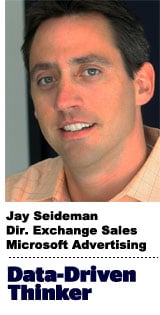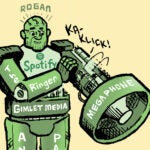 “Data Driven Thinking” is written by members of the media community and contains fresh ideas on the digital revolution in media.
“Data Driven Thinking” is written by members of the media community and contains fresh ideas on the digital revolution in media.
Today’s column is by Jay Seideman, Director of Sales, Exchange and Targeting, Microsoft Advertising
The holidays are upon us, and it is that time of year when we can reflect on the past 12 months. In the programmatic and ad network business there were many surprises in 2012. Here are four observations regarding the fascinating year that is coming to a close and my thoughts on what they might mean for our industry:
1. Brand has not yet arrived, and programmatic continued to be defined by RTB and direct response
Many thought that 2012 would be the year when a discernible shift would take place and we would see more brand dollars flow through the RTB pipeline. Looking back, this is not how it panned out.
In fact, this shift is taking a lot longer than many of us expected. In 2012, site retargeting was officially kinged. While advertisers like Kellogg’s are channelizing programmatic to achieve their branding goals, the majority of programmatic dollars continued to be aligned with direct response objectives.
What’s the way out? The industry needs to give buyers more comfort around the quality of programmatic inventory, inclusive of viewability measures, brand safety reassurance and a better definition of real attribution. And once we see more premium video inventory flow through exchanges, so will the brand budgets.
As for RTB, the benefit of only buying the inventory you need, in real time, has proven both efficient and effective for many buyers. But programmatic cannot continue to be confined to direct response, or it will remain a cottage industry. Of equal importance, programmatic cannot continue to be defined as RTB-transacted only.
A welcome surprise in 2012 was the speed with which the industry unanimously adopted the expanded definition of “programmatic” to mean more than RTB. In 2013, premium publishers will work hard to expand programmatic offerings outside of RTB, to include guaranteed and data-powered media and this innovation will benefit both their direct and indirect clients.
2. Much less M&A activity than anyone predicted
As I attended industry conferences and watched recruiters ping our inboxes this year, I was overwhelmed by the number of companies that operate in our space. If 2011 was a slow year on this front, in 2012 big acquisitions in digital media became as rare as the Twinkie.
Some of the big transactions that were done, such as Salesforce’s buyout of Buddy Media for $745m, were not the ones we anticipated. Independent companies in our space continued an awkward dance because, well, the music hasn’t stopped just yet. Companies recognized the need to focus on their own bottom lines.
But the current economic conditions are only part of the story here. The truth is that we are seeing the big companies innovate and partner like never before. Facebook didn’t buy ad tech to start their exchange, but they did launch and begin hosting their own RTB marketplace this year. Many independent companies stand to benefit from this. But FBX’s inception didn’t merit a big transaction to kick it off, somewhat surprising for a company that was recently flush with cash. Facebook instead chose to develop the marketplace itself.
In my opinion, moving forward, scores of other large companies will challenge themselves to innovate and partner, in lieu of making headlines with big acquisitions. Players looking for a buyout will have to wait longer, and if this trend holds – they may be waiting indefinitely.
3. Networks still aren’t dead. Well, some might be.
I can say without a doubt that many networks held strong and thrived in 2012. Consider this: The biggest buyers on the Microsoft Ad Exchange, eight out of the top ten in fact, are ad networks. So what separates the ones that made it from the ones that didn’t?
To survive in today’s competitive landscape, media networks need to offer differentiated access. This year, as exchanges further democratized access to display inventory for all buyers, proprietary data and multi-screen executions turned out to be the hottest differentiators. Players who have rich data at scale, from sources like search or an active user base, hold a massive advantage. Companies who can articulate and execute against multiple screens to find audiences across display, video, mobile and, in our case, Xbox, will thrive. In fact, the momentum we saw in cross platform buying was probably one prediction about 2012 that did turn out to be true.
Overall, networks are far from dead but one can’t deny that many players in our space are hurting badly. In 2012 they were largely suffering in silence and 2013 could bring more troubles to those who cannot differentiate.
4. Digital salespeople became more influential than ever.
I continued to observe what I would describe as paranoia that programmatic selling could cannibalize sales roles. This couldn’t have been further from the truth. I’ve seen the buzz regarding Federated Media’s move to cut down their direct sales team. But I don’t read that as a sign of the demise of the direct sales model across the industry.
In fact, the need for digital expertise has exploded and real sales talent remained in peak demand this year. Yes, the skills of today’s seller evolved more quickly than in years’ past. Being versed in programmatic and in how the industry “plumbing” works became table stakes for all sellers and downright essential to their effectiveness. At all levels of sales leadership we saw a continued acceptance that programmatic selling is a hard trend that is here to stay. Effectively operating multiple channels, via both direct sales and indirect partners, became a concrete pillar of future publisher strategy. At Microsoft, we proved that premium publishers can win in both RTB and direct sales, by making swift decisions on who to partner with, and by educating their sales teams.
Even with programmatic, the fundamentals of good selling are here to stay: advising the customer on what’s best, challenging buyers to select and build the right programs, connecting the dots behind the scenes and above all else, maintaining strong relationships that provide value to all involved.
We’re now primed for another revealing year in the programmatic and network space. I am very bullish and excited to see how the buy and sell sides come together to take programmatic beyond RTB in a big way. What do you think?
Follow AdExchanger (@adexchanger) on Twitter.













